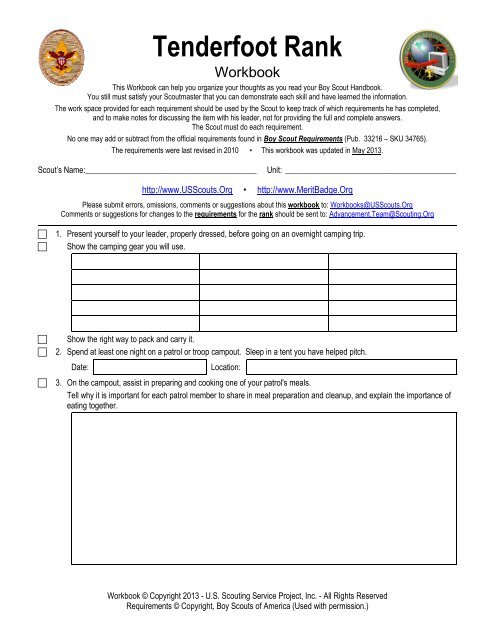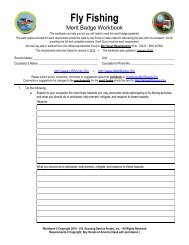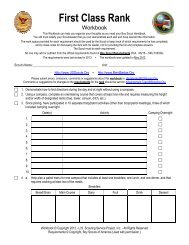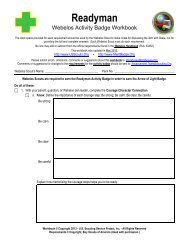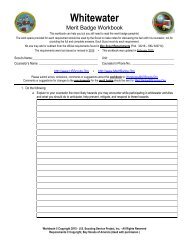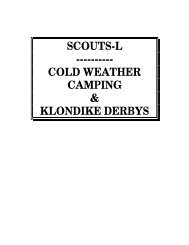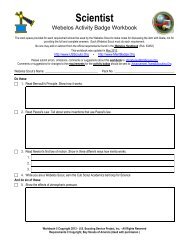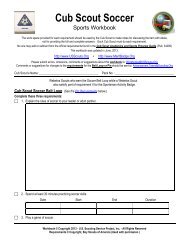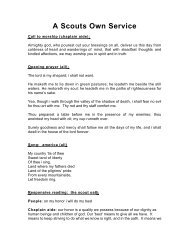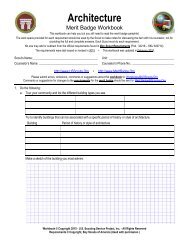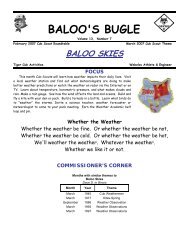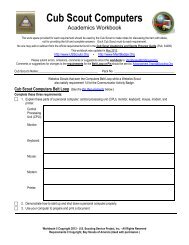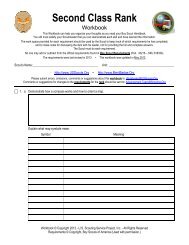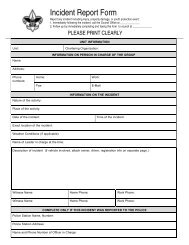Tenderfoot rank Worksheet
Tenderfoot rank Worksheet
Tenderfoot rank Worksheet
Create successful ePaper yourself
Turn your PDF publications into a flip-book with our unique Google optimized e-Paper software.
<strong>Tenderfoot</strong> RankScout's Name: ________________________ 4. a. Demonstrate how to whip and fuse the ends of a rope.b. Demonstrate you know how to tie the following knots and tell what their uses are: two half hitches and the taut-linehitchtwo half hitchestaut-line hitch. c. Using the EDGE method, teach another person how to tie the square knot.EDGE 5. Explain the rules of safe hiking, both on the highway and cross-country, during the day and at night.Safe hiking on the highway:Safe hiking cross-country:Safe hiking during the day:Safe hiking at night:Explain what to do if you arelost:<strong>Tenderfoot</strong> Rank Workbook Page 2 of 7
<strong>Tenderfoot</strong> RankScout's Name: ________________________ 6. Demonstrate how to display, raise, lower, and fold the American flag. 7. Repeat from memory and explain in your own words the Scout Oath, Law, motto, and slogan.Scout Oath:Scout Law:Scout motto:Scout slogan 8. Know your patrol name, give the patrol yell, and describe your patrol flag.Patrol NamePatrol YellPatrol Flag 9. Explain the importance of the buddy system as it relates to your personal safety on outings and in your neighborhood.On outings:In your neighborhood:<strong>Tenderfoot</strong> Rank Workbook Page 3 of 7
<strong>Tenderfoot</strong> RankScout's Name: ________________________Describe what a bully is and how you should respond to one. 10. a. Record your best in the following tests:● Push-ups ● Pull-ups ● Sit-ups ● Standing long jump ● 1/4 mile walk/run b. Show improvement in the activities listed in requirement 10a after practicing for 30 days.First Test Second Test ImprovementActivity :Push-upsPull-upsSit-upsStanding Long JumpDate:(number)(number)(number)(Feet-inches)1/4 mile walk/run (Minutes-seconds) 11.Identify local poisonous plants; tell how to treat for exposure to them. 12. a. Demonstrate how to care for someone who is choking.<strong>Tenderfoot</strong> Rank Workbook Page 4 of 7
<strong>Tenderfoot</strong> RankScout's Name: ________________________ b. Show first aid for the following: Simple cuts and scrapes Blisters on the hand and foot Minor (thermal/heat) burns orscalds (superficial, or first degree) Bites and stings of insects andticks Venomous snakebite Nosebleed Frostbite and sunburn<strong>Tenderfoot</strong> Rank Workbook Page 5 of 7
<strong>Tenderfoot</strong> RankScout's Name: ________________________ 13.Demonstrate Scout spirit by living the Scout Oath (Promise) and Scout Law in your everyday life.Discuss four specific examples of how you have lived the points of the Scout Law in your daily life.1.2.3.4. 14. 15.Participate in a Scoutmaster conference.Complete your board of review.Notes:Alternate Requirements for the <strong>Tenderfoot</strong> <strong>rank</strong> are available for Scouts with physical or mental disabilities if they meet thecriteria listed in the Boy Scout Requirements book. Click here to learn more, and see the information from the Guide toAdvancement at the end of this workbook.The requirements for <strong>Tenderfoot</strong>, Second Class, and First Class <strong>rank</strong>s may be worked on simultaneously; however, these<strong>rank</strong>s must be earned in sequence.Requirement resources can be found here:http://www.meritbadge.org/wiki/index.php/<strong>Tenderfoot</strong> Rank/#Requirement resources<strong>Tenderfoot</strong> Rank Workbook Page 6 of 7
Important excerpts from the Guide To Advancement - 2013, No. 33088 (SKU-618673)[1.0.0.0] — IntroductionThe current edition of the Guide to Advancement is the official source for administering advancement in all Boy Scouts of America programs: CubScouting, Boy Scouting, Varsity Scouting, Venturing, and Sea Scouts. It replaces any previous BSA advancement manuals, including AdvancementCommittee Policies and Procedures, Advancement and Recognition Policies and Procedures, and previous editions of the Guide to Advancement.[Page 2, and 5.0.1.4] — Policy on Unauthorized Changes to Advancement ProgramNo council, committee, district, unit, or individual has the authority to add to, or subtract from, advancement requirements. There are limitedexceptions relating only to youth members with special needs. For details see section 10, “Advancement for Members With Special Needs”.[Page 2] — The “Guide to Safe Scouting” AppliesPolicies and procedures outlined in the Guide to Safe Scouting, No. 34416, apply to all BSA activities, including those related to advancement andEagle Scout service projects.[10.2.2.0] — Advancement for Boy Scouts and Varsity Scouts With DisabilitiesMembers must meet current advancement requirements as written for merit badges, all <strong>rank</strong>s, and Eagle Palms, although some allowablesubstitutions or alternatives are specifically set forth in official literature. The member is expected to meet the requirements—no more and no less—and he is to do exactly what is stated. If it says, “Show or demonstrate,” that is what he must do; just “telling” isn’t enough. The same holds for wordsand phrases such as “make,” “list,” “in the field,” “collect,” “identify,” and “label.” Requests for alternative requirements for <strong>Tenderfoot</strong>, Second Class,and First Class <strong>rank</strong>s can be made using the information outlined below.It is important to remember that the advancement program is meant to challenge our members; however, not all of them can achieve everything theymight want to—with or without a disability. It is for this reason all Scouts are required to meet the requirements as they are written, with no exceptions.For boards of review for Scouts with special needs, the board members should be informed ahead of time about the special circumstances and needs.It may be helpful, too, if the unit leader is present at the review. He or she may be able to help answer questions and provide background. It may beimportant to allow parents or guardians to be present at the meeting as well—especially if they are able to help interpret and communicate what theScout is saying. At the least, parents should be available to help board members understand the Scout’s challenges and how he copes with them.[10.2.2.1] — Using Alternative RequirementsA degree of modification in advancement requirements may be necessary to mainstream as many members with disabilities as possible. Thus a Scoutwith a permanent physical or mental disability (or a disability expected to last more than two years or beyond the 18th birthday) who is unable tocomplete all the requirements for <strong>Tenderfoot</strong>, Second Class, or First Class <strong>rank</strong> may, with his parent or guardian, and also the unit leader or a memberof the troop committee, submit a request to the council advancement committee to complete alternative requirements. Unless a Scout has beenapproved to register beyond the age of eligibility, alternative requirements must be completed by the 18th birthday. The procedures appear below.This avenue is also available to youth with longer-term disabilities (such as those related to a severe injury) who want to continue advancing duringrecovery.Simple modifications very close to existing requirement need not be approved. A Scout in a wheelchair, for example, may meet the Second Classrequirement for hiking by “wheeling” to a place of interest. Allowing more time and permitting special aids are also ways leaders can help Scouts withdisabilities make progress. Modifications, however, must provide a very similar challenge and learning experience.Alternatives are not available for the Star, Life, and Eagle <strong>rank</strong> requirements. Scouts may request approval for alternative merit badges, but the otherrequirements for those three <strong>rank</strong>s must be fulfilled as written.The outcomes of the Scouting experience should be fun and educational, and not just relate to completing <strong>rank</strong> requirements that might placeunrealistic expectations on a member who has special needs.[10.2.2.2] — How to Apply for Alternative RequirementsBefore applying for alternative requirements, members must complete as many of the existing requirements as possible. Once they have done theirbest to the limit of their abilities and resources, the unit leader or a troop committee member submits to the council advancement committee a writtenrequest for alternative requirements for <strong>Tenderfoot</strong>, Second Class, and First Class <strong>rank</strong>s. It must show what has been completed, and suggest thealternatives for those requirements the Scout cannot do.The request must be accompanied by supporting letters from the unit leader, a parent or guardian, and the member (if possible), as well as a writtenstatement from a qualified health professional related to the nature of the disability. This may be, for example, a physician, neurologist, psychiatrist,psychologist, etc., or when appropriate, an educational administrator in special education. Statements must describe the disability; cover the Scout’scapabilities, limitations, and prognosis; and outline what requirements cannot be completed. Additional information such as Individualized EducationPlans provided to parents by schools, and various treatment summariesNormally, it is expected that youth with only moderate learning disabilities, or such disorders as ADD or ADHD can—albeit moreslowly—complete standard requirements.The advancement committee reviews the request, using the expertise of professionals involved with youth who have special needs. To make a fairdetermination, the committee may want to interview the Scout, his parent(s) or guardian(s), and the unit leader. The committee’s decision is thenrecorded and delivered to the Scout and the unit leader.Note that topics 10.2.2.1 and 10.2.2.2 do not apply to merit badge requirements. See topic 10.2.2.3 to learn about earning alternative merit badges tothose required for Eagle.Attachment (NOTE: It is not necessary to print this page.) Page 7 of 7


